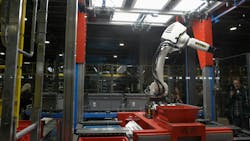How predictive AI can help manufacturers forecast demand for their products
What you’ll learn:
- Predictive AI offers not just an incremental improvement, but a fundamental rethinking of how manufacturers anticipate and act on demand.
- When one manufacturer turned to predictive AI, they achieved a 25% reduction in inventory expenses and a 15% drop in labor costs.
- Predictive AI doesn't eliminate human judgment—it amplifies it. The best results come when planners use AI not as a black box, but as a collaborative partner.
For decades, manufacturers have relied on forecasting models that assume the past is a reliable predictor of the future. Today, that assumption is crumbling. Market volatility, supply chain disruptions, and shifting consumer behaviors have exposed the cracks in traditional methods. What once offered a competitive advantage is now an operational liability.
Manufacturers who continue to forecast using static, linear models risk flying blind in an increasingly dynamic world. Overproduction, stockouts, excess inventory, misallocated labor—these are not anomalies. They are the inevitable consequences of outdated thinking.
See also: Survey: Firms see ‘smart’ manufacturing investments paying off in productivity, capacity gains
The good news is that a better way has emerged. Predictive AI offers not just an incremental improvement, but a fundamental rethinking of how manufacturers anticipate and act on demand.
The real cost of sticking to old ways
Consider the experience of a global technology manufacturer recently caught in the friction between complexity and legacy forecasting. Struggling to manage SKU-level demand across international markets, they faced ballooning inventory costs and inefficient labor allocation. Historical trendlines simply couldn't keep pace.
What is your company doing about cybersecurity?
When they turned to predictive AI, integrating diverse, real-time data from sales, marketing, and supply chain operations, they achieved a 25% reduction in inventory costs and a 15% drop in labor expenses. These aren't hypothetical results; they are hard proof that manufacturers who modernize their forecasting gain measurable, strategic advantages
Podcast: Arming frontline workers with AI tools that work
According to Gartner, top-performing manufacturers—those that excel at forecasting—carry 15% less inventory, achieve 17% better order fulfillment, and generate 60% higher profit margins than their peers. In today’s hypercompetitive environment, those margins can be the difference between thriving and merely surviving.
In today's landscape, accuracy isn't a nice-to-have. It's a competitive moat, and those without it risk falling behind at an accelerating pace.
What predictive AI actually changes
Predictive AI is not just a better forecast engine. It fundamentally changes the DNA of planning.
Unlike traditional models that project forward from yesterday's patterns, predictive AI continuously adapts in real time. It captures complex, nonlinear relationships among variables like seasonality, channel dynamics, marketing activity, and external shocks. Instead of offering a single prediction, it provides a range of probable outcomes, each with an associated confidence level.
See also: Agentic leaps past Gen-AI in its ability to solve production plant problems
This shift from static predictions to dynamic probability modeling transforms decision-making. Manufacturers are no longer trapped reacting to missed forecasts. They are empowered to optimize production, logistics, and resource allocation with greater agility and far less risk.
Moreover, predictive AI introduces flexibility. It allows manufacturers to run multiple "what-if" scenarios rapidly, exploring how changes in marketing spend, supplier availability, or consumer trends might impact demand forecasts. This ability to stress-test different assumptions is a major leap beyond the rigid, one-track forecasts of the past.
In short, predictive AI doesn't just forecast better; it turns forecasting into a living, learning system.
Proof that it works
And this isn’t just theory. Leading manufacturers are already seeing real-world results.
Procter & Gamble used AI-driven forecasting to slash excess inventory by 25% and dramatically enhance supply chain agility. Meanwhile, a industrial manufacturer saw a 30% jump in forecast accuracy and a 25% reduction in stockouts after deploying AI models across their regional hubs.
These gains aren’t just for the giants anymore. As predictive AI platforms become more accessible, even mid-sized and smaller manufacturers can now afford to leapfrog outdated systems and compete at a much higher level.
This democratization of predictive capabilities means the barriers to innovation are lower than ever. The opportunity is wide open, but so is the risk of being left behind.
See also: Leveraging real-time production data: Q&A with Adam Mullen
Importantly, predictive AI doesn't eliminate human judgment—it amplifies it.
The best results come when planners use AI not as a black box, but as a collaborative partner. Modern AI platforms empower teams to interpret predictions, stress-test assumptions, and act decisively without requiring technical expertise. They create a new dynamic where human intuition and machine intelligence enhance each other rather than compete.
This shift elevates the role of human expertise. Leaders can focus less on crunching numbers and more on strategic decision-making—asking smarter questions, exploring new markets, and innovating faster. Predictive AI frees up human creativity, ensuring that companies aren’t just more efficient, but also more resilient and visionary. Organizations that embrace this partnership mindset will outpace those that view AI as simply another tool or bolt-on technology.
A new strategic imperative
Manufacturing is entering a new era where the winners will be defined not just by what they produce, but by how intelligently they anticipate the future. Predictive AI is no longer a future trend. It is the present reality for those serious about operational excellence.
See also: Real use cases: Unlocking measurable efficiencies by harnessing AI
The era of guesswork is over.
The question is not whether manufacturers will adopt predictive AI. The question is whether they will do so fast enough to survive the next wave of disruption—and emerge as leaders in the new, intelligence-driven economy.
About the Author

Zohar Bronfman
Zohar Bronfman is CEO and co-founder of Pecan AI, vendor of a no-code predictive analytics software platform. With expertise in computational psychology and data science, Bronfman applied his inherent entrepreneurial spirit to co-found Pecan out of graduate school.
